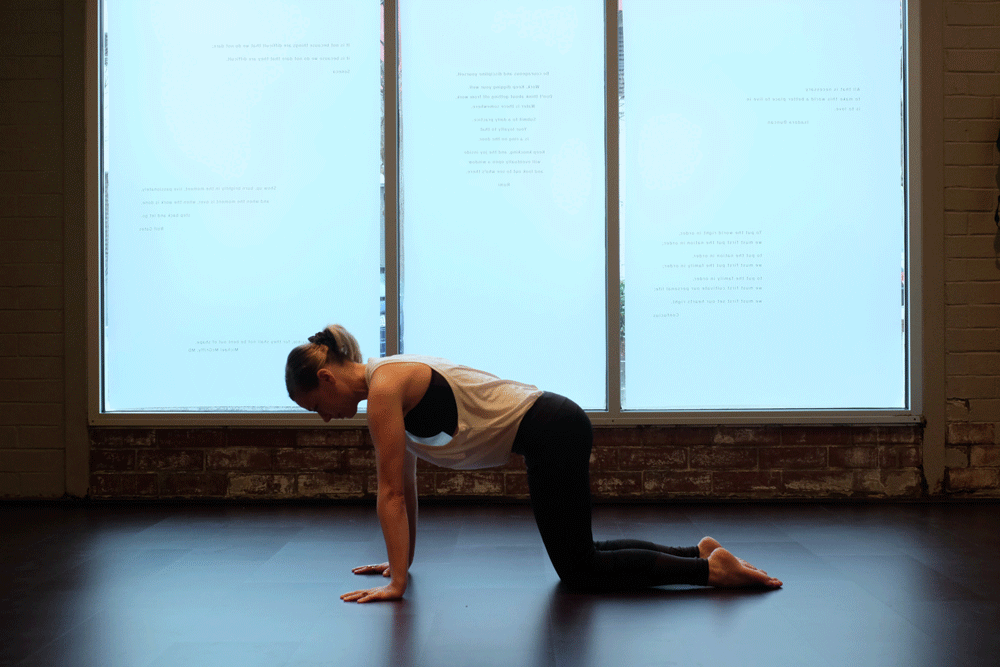Article by Andrea Rice.
Yoga is for everybody, yet what is often considered as “advanced” is conflated with flexibility, hyper-mobility and even contortionism. As a rule of thumb, an advanced practice stems from a place of inherent wisdom. So long as there is awareness of breath and attention to body, there is yoga taking place. So long as we are skillfully participating in an activity and cultivating presence, we are experiencing the essence of what yoga really is. When we learn how to be okay with what is by letting go of what is not, we can more readily accept things as they are and accept ourselves as we are. And it only takes a commitment of just a few minutes in the morning to set this positive tone for the rest of your day.
More and more research has shown that just a few minutes of movement a day can have a positive impact on our physical vitality and longevity, while commitment to meditation can decrease stress and improve our overall happiness quotient. When ego-driven motivators like the need to sweat or achieve or push are removed from the equation, yoga is an effective form of movement as meditation. So while we don’t always have the time for 60 minutes at the studio or 20 minutes seated on the cushion, we can always carve out a little space for self-practice on the mat.
Try this following series of movement patterns to jumpstart your morning, repeating each circuit as often as you wish. Be sure to save a little time at the end of your practice for a short Savasana or a brief seated meditation.
Rise and Shine
This opening sequence begins by gently stretching the spine through extension and flexion, and then strengthens and stabilizes the shoulder girdle while opening up the lateral side-body.
Begin in a tabletop position on all fours, with knees just behind your hips and palms placed just wide of your elbows. Find an anchor in your index fingers and thumbs and draw your spine to neutral. You can synchronize movement to breath, using an inhale to push the floor away and lift the back of your heart into Cat Pose, and an exhale to draw your chest forward—without collapsing your belly—to Cow Pose. Repeat a few times to warm up your spine, then step your right foot back and tuck your toes under. Engage your right glute and lift your right leg to about hip height. Shift your left shin behind you at about 45 degrees like a kickstand and dome your right fingertips to shift weight into your left hand. Turn the left side of your ribs underneath you and bring your right hand to your right hip as you stack the hips. Bend your right knee, draw your right foot to your right glute, and grab your right foot or ankle with your hand as you reach through your crown. Release the foot long behind you, letting just the big toe pad touch the floor as you float your right palm to the sky. Return to hands and knees and repeat on the other side.

Up and At ‘Em
This next movement pattern activates the anterior and posterior chain (front- and back-body) by targeting the deep core muscles.
From a tabletop position with the toes tucked under, begin shifting your weight back and forth, springing out from the backs of the toes and engaging the glutes to stabilize the hips and pelvis. Then, begin “marching” as you lift the right knee, followed by the left, similar to mountain climbers, but just by lifting and lowering one knee at a time, keeping your back-body lifted. Now, lift both knees and really push the floor away so that you establish a high plank from all fours. From plank, send your hips up and back to Adho Mukha Svanasana (Downward Dog), but keep your knees bent and heels lifted and emphasize a long and neutral spine. Come back to plank, then drop your heels to the left and bring your right hand to your right hip, followed by the other side. Return to Dog Pose, and then lower your knees back to a tabletop. You might rest for a moment in a Child’s Pose before moving on.

Fire It Up!
This final heat-generating circuit builds on the activation of the posterior chain (back-body and glutes) and incorporates shoulder extension.
From tabletop, shift your hips up and back to Downward Dog. Shift forward and step your right foot next to your right thumb. Lower your back knee and float your biceps by your ears or to frame your face and keep your toes tucked under. Lift your back knee and reach your arms back and behind you to come to an Arrow Lunge variation. Lower your back knee again and reach your arms overhead to a stabilized Anjaneyasana (Low Lunge) with a 90-degree bend in each knee. Next, take an open twist to the right, revolving from the rib cage and sending the arms out wide without “cranking.” Then place your left hand to the floor or a block, and reach your right fingertips to the sky, inviting the left side of your ribs to turn underneath you. Lift your back knee (yes, again!), and be sure that you’re still breathing deeply. Frame your front foot with both hands and anchor the outer edge of your back foot down for Parsvottanasana (aka Intense Side Stretch) by hopping that foot slightly in. Soften your knees to hinge forward with more ease. Bend through your front knee and lift your back heel to step back to Dog Pose. Lower to all fours and rest for a moment, then return to Downward Dog to repeat on the left side. Namaste.

Credits
Photography: Shot by Finn Cohen; Edited by Elizabeth Kessler; Animated by Andrea Rice
Location courtesy of Blue Lotus
Outfitted by Adidas X Wanderlust
